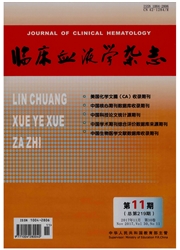

 中文摘要:
中文摘要:
目的:建立一套体外培养前B急性淋巴细胞白血病(ALL)原代细胞的方法,并尝试进行难治性白血病克隆的鉴定。方法:采用来源于骨髓的基质细胞HS-5作为滋养层细胞与原代白血病细胞进行双相培养。并通过药敏和凋亡检测进行双相培养体系生物动力学评估。结果:双相滋养层培养体系能够耐受细胞毒药物的毒性;8例前B急淋白血病原代细胞标本在基质滋养层支持下离体72h存活率20.4%~68.3%不等。与无滋养层支持或基质细胞上清液支持的标本相比存活率有显著性提高;其中1例标本的体外生长与有否滋养层支持无关,怀疑为难治性白血病克隆。结论:骨髓基质细胞来源的滋养层具有一定的体外支持白血病细胞存活的能力,但存在个体差异,与肿瘤细胞本身生物学特征有关;利用双相培养体系可以在体外早期初步鉴别出难治性白血病克隆并早期制定干预措施。
 英文摘要:
英文摘要:
Objective: To establish a bi-phase system for the culture of primary B-lineage precursor leukemia cells in vitro and attempt to identify aggressive leukemic clone. Method: An immortalized human bone marrow stromal cell line, HS-5, was emplnyed as a feeder layer to establish a bi phase culture system for the cultivation B lineage precursor acute lymphohlastie leukemia cells. Meanwhile, the culture system was evaluated by drug toxicity assay and apoptotic testing. Result:The hi-phase culture system can tolerate the cell toxic drug induced apoptosis. Survival of B-lineage precursor lymphocytic leukemia cells in 7 of 8 eases of studied samples can be maintained with this hi phase culture system. In contrast, the remaining 1 case of sample can survive regardless of the existing of feeder layer. Conclusion: The bi-phase culture system is qualified for the cultivation of primary Pre-B leukemia ceils but this survival supporting capability is varied from individual leukemia samples. Through the hi phase culture, aggressive leukemic sample might he identified.
 同期刊论文项目
同期刊论文项目
 同项目期刊论文
同项目期刊论文
 期刊信息
期刊信息
